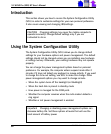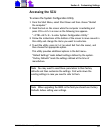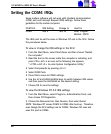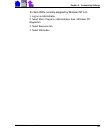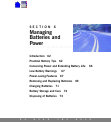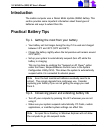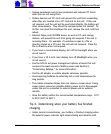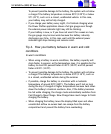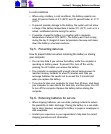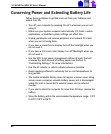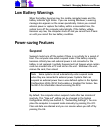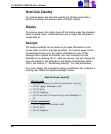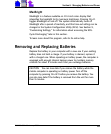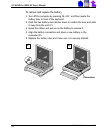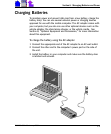
64
X-C 6250 Pro (300) NT Users Manual
79-0030-001 11 January 2001
To prevent possible damage to the battery, the system will not allow
a charge if the battery temperature is above 50°C (122°F) or below
5°C (41°F), such as in a closed, unattended vehicle. In this case,
your battery may not be fully charged.
• If you charge your battery every night, it is finished charging when
the Power Profiler application shows a full gas gauge even though
the external power indicator light may still be blinking.
If your battery is new, or if you have not used it for a week or more,
the gas gauge may be inaccurate because the battery naturally
discharges over time. In this case, wait until the external power
indicator light stops blinking and remains solid.
Tip 4. How your battery behaves in warm and cold
conditions
In warm conditions
• When using a battery in warm conditions, the battery capacity will
drain faster. In general, as the temperature rises, it is possible for the
battery to drain 20 percent faster at 40°C (104°F) and 50 percent
faster at 45°C (113°F).
• To prevent possible damage to the battery, the system will not allow
a charge if the battery temperature is above 45°C (113°F), such as
in a closed, unattended vehicle during the summer.
• If possible, charge the battery in a location with a moderate
temperature of around 20°C (68°F). The battery wont last as long
during the day if charged at higher temperatures because heat slows
down the batterys chemical reactions. Also, if the battery becomes
too hot while charging, the charge mode automatically switches from
Fast Charge to Slow Charge. Slow Charge takes much longer to finish
charging the battery.
• When charging the battery, leave the display tilted open and allow
unrestricted airflow so excess heat can escape from the battery
compartment and prevent the battery from overheating.



